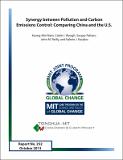Synergy between Pollution and Carbon Emissions Control: Comparing China and the U.S.
Author(s)
Nam, Kyung-Min; Waugh, Caleb J.; Paltsev, Sergey; Reilly, John M.; Karplus, V.J.
DownloadMain article (2.047Mb)
Metadata
Show full item recordAbstract
We estimate the potential synergy between pollution and climate control in the U.S. and China, summarizing the results as emissions cross-elasticities of control. We set a range of NOx and SO2 targets, and record the ancillary reduction in CO2 to calculate the percentage change in CO2 divided by the percentage change in NOx (SO2) denoted as ECO2,NOx (ECO2,SO2). Then we conduct the opposite experiment, setting targets for CO2 and recording the ancillary reduction in NOx and SO2 to compute ENOx,CO2 and ESO2,CO2. For ECO2,NOx and ECO2,SO2 we find low values (0.06‒0.23) in both countries with small (10%) reduction targets that rise to 0.40‒0.67 in the U.S. and 0.83‒1.03 in China when targets are more stringent (75% reduction). This pattern reflects the availability of pollution control to target individual pollutants for smaller reductions but the need for wholesale change toward non-fossil technologies when large reductions are required. We trace the especially high cross elasticities in China to its higher dependence on coal. These results are promising in that China may have more incentive to greatly reduce SO2 and NOx with readily apparent pollution benefits in China, that at the same time would significantly reduce CO2 emissions. The majority of existing studies have focused on the effect of CO2 abatement on other pollutants, typically finding strong cross effects. We find similar strong effects but with less dependence on the stringency of control, and stronger effects in the U.S. than in China.
Date issued
2013-10Publisher
MIT Joint Program
Citation
Report 252
Series/Report no.
MIT Joint Program Report Series;Report 252